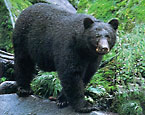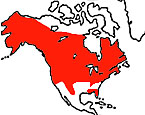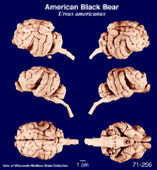|
American
Black Bear
(Ursus americanus) #71-256 |
||||
|
|
Physical
characteristics and distribution
|
|
The American Black Bears vary in length from 15,00 to 18,00 mm; tail length is about 120 mm. Body weights vary from 92--140 kg for females land 115-270 kg for males. The most common color phases are black, chocolate brown and cinnamon brown. Different colors may occur in the same litter. The American Black Bear occurs mainly in forested areas. The usual locomotion is a lumbering walk. It swims and climbs well. It moves about at any time of day, but is mostly active at night. Like other bears that sleep through the winter, it becomes fat as fall approaches, and with colder weather it goes into a den, ceases eating, and hibernates for several months. The den may be in a hollow tree or log, or in a burrow. The winter sleep may be interrupted by excursions for food if the weather is warm. Hibernation begins as early as October and may last until May. At least 75 percent of the diet consists of vegetable matter, especially fruit, berries, nuts, acorns, grass and roots. The diet also includes insects, fish, rodents, carrion, and occasionally larger mammals. Ranges of males do not overlap one another, but the ranges of females overlapped with those of males and occasionally with those of other females. The sexes come together briefly during mating season, which peaks from June to mid-July. Females remain in estrus throughout the season until they mate. They usually give birth every other year, but sometimes wait 3-4 years. Pregnancy lasts about 220 days, buts there is delayed implantation until autumn. Births occur in January and February, commonly while the female is hibernating. Litter sizes ranges from 1-5. Cubs are weaned at around 6-8 months, but remain with the mother, and den with her during their second winter of life. The distribution of the American Black Bear has declined substantially with human encroachment on their territory, but they are still common in Canada, Mexico (N Nayarit and S Tamaulipas), and USA. |
|
Description
of the brain
|
|
Animal
source and preparation
|
|
All
specimens collected followed the same preparation
and histological procedure.
|
Other Related Resources (websites and publications)
List of Specimens | Explore Collections | Brain Sections | Brain Evolution | Brain Development | Brain Circuitry | Brain Functions | Location and Use | Related Web Sites | Contact Us | Search MSU Database | Personnel | Home



